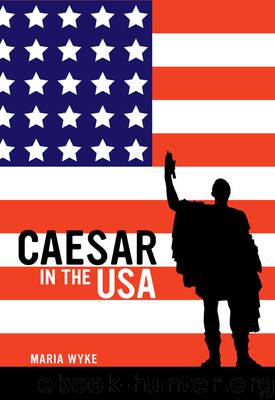Caesar in the USA by Wyke Maria

Author:Wyke, Maria
Language: eng
Format: epub
Publisher: University of California Press
Published: 2012-03-04T16:00:00+00:00
FIGURE 26. Paul Newman as Brutus, in You Are There’s “The Assassination of Julius Caesar” (8 March 1953). © CBS News Archive.
The CBS network, even in its studio-based opening and conclusion, offered no explicit illumination of present times. It is the television audience, who, in the privacy of their own homes, have to take responsibility for seeing a historical analogy (and for making the implicit criticism that the insight might entail). The series You Are There cleverly camouflaged its attacks on McCarthyism with the aesthetic cover of history.108 Only retrospective analysis of the context in which the television series was produced and of the biographies of some of its makers brings its political agenda completely out into the open. All three of the chief scriptwriters for the series were on the blacklist and were therefore writing under pseudonyms. One of them subsequently declared that the series was probably the only place where any guerrilla warfare was conducted against McCarthy in a public medium, since its historical themes were generally selected for their bearing on the terrors he perpetrated—a serial historiography (the scriptwriter claimed) of losses of civil liberties and intellectual freedoms, investigations, witch hunts, trials, recantations, and executions.109
MGM’s Julius Caesar, however, began to be understood explicitly as an assault on McCarthyism only later, during the film’s regional run, when the same network that had produced “The Assassination of Julius Caesar” aired a television documentary that openly attacked the junior senator from Wisconsin for being—among other things—America’s modern-day Caesar. At 10:30 p.m. EST on Tuesday, 9 March 1954, CBS broadcast “A Report on Senator Joseph R. McCarthy” in its weekly half-hour news magazine series See It Now. Earlier programs in the series had already dissected examples of the abusive tactics McCarthy deployed to weed out Communists from American institutions, but this telecast was the most controversial. It retains a legendary status as the most courageous and influential documentary in television history (even though some critics now consider it to be a late follow-up by the otherwise timid medium on more rigorous critiques that had already appeared in the press).110 Thus, in 2005, sequences from the telecast were reconstructed as the climax of a Hollywood film about television’s exposé of McCarthy—Good Night, and Good Luck (dir. George Clooney)—and interpreted by spectators as part of a robust history lesson from the director on how contemporary broadcasters might be able to stand up courageously against the manipulations and repressions of the administration of George W. Bush.111
The telecast (as well as See It Now as a whole) was hosted by Edward R. Murrow, who was famous and much admired for his wartime radio reports from Europe. In the broadcast, McCarthy was presented as a shallow, sweaty, bullying demagogue tossing about wild and slapdash charges of treason and espionage. The unpleasant portrait was achieved by careful editing of newsreel footage and audiotapes of the senator’s own outrageous public statements, a catalogue of increasingly scathing criticisms made against him by the highest members of the establishment, and censorious interventions throughout from Murrow live in the CBS studio.
Download
This site does not store any files on its server. We only index and link to content provided by other sites. Please contact the content providers to delete copyright contents if any and email us, we'll remove relevant links or contents immediately.
| Dance | Individual Directors |
| Magic & Illusion | Reference |
| Theater |
Call Me by Your Name by André Aciman(18967)
Ready Player One by Cline Ernest(12841)
How to Be a Bawse: A Guide to Conquering Life by Lilly Singh(6693)
Wiseguy by Nicholas Pileggi(4586)
The Kite Runner by Khaled Hosseini(4438)
On Writing A Memoir of the Craft by Stephen King(4215)
The Crown by Robert Lacey(4105)
Audition by Ryu Murakami(4099)
Call me by your name by Andre Aciman(4073)
Harry Potter and the Cursed Child: The Journey by Harry Potter Theatrical Productions(3966)
Gerald's Game by Stephen King(3919)
The Perils of Being Moderately Famous by Soha Ali Khan(3783)
Dialogue by Robert McKee(3583)
Dynamic Alignment Through Imagery by Eric Franklin(3489)
Apollo 8 by Jeffrey Kluger(3201)
How to be Champion: My Autobiography by Sarah Millican(3186)
Seriously... I'm Kidding by Ellen DeGeneres(3100)
Darker by E L James(3088)
History of Dance, 2E by Gayle Kassing(3000)
